Foreign Insulators
by Marilyn Albers
Reprinted from "Crown Jewels of the Wire", March 1987, page 22
A QUESTION ANSWERED (and another one asked)
In my most recent column, appearing in the January, 1987 issue of CROWN
JEWELS OF THE WIRE, I showed you a picture of a glass Christmas tree shaped
object which was reportedly used as an insulator on a telegraph pole in Jamaica
around 1920.
Three Chiefs of Insulatordom gave their opinions: "Well, it's
NOT an insulator, that's for sure!" scoffed N.R. "Woody"
Woodward. "NO WAY," thundered Jack Tod from Phoenix. And all the way
from Guernsey, Channel Islands, Keith Neal added, "I have never in my life
set eyes on such a thing! I must conclude that it is a genuine `whatisit.'"
Readers were asked for comments. A short time later I received the following
letter from Jim Sovaiko, who is President of ARCO CORPORATION of Throop,
Pennsylvania. This firm markets energy meter lamps. Accompanying Jim's letter is
a portion of the page out of the trade journal to which Jim refers.
 |
Dear Marilyn,
Regarding your column in the current issue of "Crown Jewels",
enclosed is a page taken from a Chinese trade magazine which illustrates one
use for that mysterious "insulator".
When Turned upside down, the funnel-shaped bottom acts as a funnel for
whatever dry samples are to be bottled. A stopper is then inserted, and the
container then serves to display the contents.
The Jamaican agricultural origin of the item may lend credence for this
suggested use, as seeds and crop samples may have been displayed therein.
Sincerely,
Jim Sovaiko
President |
 |
Many thanks for your comments, Jim! I, for one, am satisfied that our
"insulator" is merely a container for displaying dry samples, and
these were probably used in several countries, including Jamaica. Perhaps
someone there actually did put one of them up on that telegraph pole for
whatever reason! Target practice? Decoration? Who knows?
NOW, since making waves does sometimes get good results, I have another
"whatisit" to show you. This one belongs to Ward Lindstrom of
Turnersville, New Jersey. Woody seems to think this one could be an insulator,
since he recalls seeing somewhere (?) the LA BASTIE patent for a bottle
insulator. Unfortunately, we can't seem to find it. Maybe I'll discover that
this patent was written up in one of the past issues of CROWN JEWELS and that
the new CROWN JEWELS OF THE WIRE TOPIC INDEX will tell which one! I've just
ordered a copy. Even if the LA BASTIE patent doesn't cover this exact same
design, it would at least substantiate the fact that Ward's "little
bottle" is an insulator of some kind.
Ward says that the insulator (?) pictured above came to him at the same time
as he received some pieces from Chile. He goes on to say:
"I don't know that this is from Chile, but like the colors I have of
Chilean pieces, this one is not a true any color. This "thing" is a
dark blue -- close to a teal blue and very lovely. There is a hole in the top and
it has a closed bottom. It looks like a converted perfume bottle. It holds 2
tablespoons of water that does not come out when tipped upside down. The glass
is thick and heavy, the skirt is a little wrinkled and the inside cavity is
irregular. A mold line goes all the way to the top. This piece was in a museum
as an insulator, but.....??? I would appreciate your view." WARD LINDSTROM
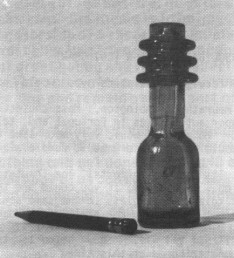
Size: 4-3/8" tall
Base: 1-5/16" wide
Tip: 3/4" across
EDITOR'S NOTE: Marilyn, thank you for the "plug" about the CROWN
JEWELS OF THE WIRE TOPIC INDEX. I did look to see if there had been anything
written on such an item in CROWN JEWELS. The INDEX only turns up information if
it has been printed, it won't perform miracles!" When there was no listing,
I checked back issues of CROSS ARMS magazine. With the permission of Editor Jim
Garrity, I offer the following information from the November, 1972 issue (page
29):
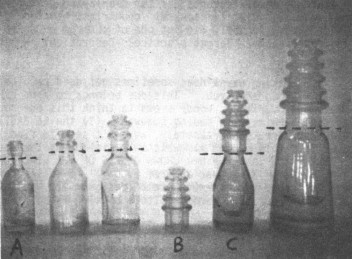
This picture shows capacitor bushings at an unfinished point during the
manufacturing process. They are made in a automatic bottle making machine. The
dotted line shows where they are cut off the bottle to become a bushing.
"B" is the finished product. "A" is top contender for
"smallest glass insulator" since it measures 3/16" x 3/16".
Husband John has several of these little bottle bushings floating around in
our basement here at the house. Of course, there may be some other opinions
offered by CROWN JEWELS readers.
NEW ASSIGNMENTS TO THE CONSOLIDATED DESIGN (CD) CHART
I promised to show you some foreign insulators you would not believe. I
wasn't kidding!
The first one belongs to Joe Maurath of Abington, Massachusetts.
When he was 16 he wrote to the proper authorities in Portugal and told them he
collected glass insulators. He said he would very much like to have one from
that country, and could they please make it purple since he was fond of that
color.
He certainly got wonderful results from his efforts! The insulator they
sent resembles a CD 128, and oh, my kingdom, if you could see the true color! It
is a soft mauve milkglass -- milkglass in the same sense as the Hemingray jade
milk. It is not solid, you can still see through it.
The insulator is marked CV/CTT
951 VA1 - 1. Shown below is the manufacturer's trademark, which is unattributed
at this time.
Joe's Portuguese insulator (2-5/8" x 4-1/2") has been
classified as CD 428 and is shown in the photo on the left below. It is taller
than the American CD 128 clear Pyrex CSA which you see on the right (2-5/8"
x 4"). Also notice the difference in shape of crown.
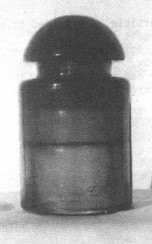
CD 428 A mauve milkglass piece from Portugal. Embossing is:  |
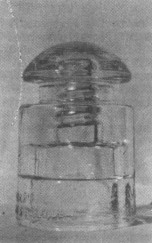
CD 128 Pyrex CSA |
Hold onto you hats for this next one! I had the good fortune to be able to
draw and photograph an actual example of (old) CD 798 as shown in Milholland. It
belongs to Bill Willinsky of Portland, Connecticut, and he brought it to the
National Show in Saratoga Springs, New York, last summer. My picture didn't turn
out as well as John McDougald's, so I am using his here instead. This insulator
is a deep RED amber! Makes a person want to just stare and stare at it in
disbelief. It is very tiny (2-1/4" base, 2-3/4" armspread, 2-7/8"
height), and the smallest of any of the glass "T-bars" we have seen to
date.
There is no marking at all on the insulator, but Bill told me it came from
Majorca, a Spanish island located in the Western Mediterranean Sea and very
close to Spain itself. The only 2 examples that are known to exist are both in
Bill's family. I had been trying to see one of these for ever so long. Patience
pays off!
|
The bottom line is that this former CD 798 has now been reclassified as CD
680.
As red an insulator as you would ever see...A CD 680 from Majorca.
|
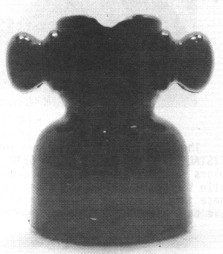 |
On to the next goodie! Earlier in this article, I referred briefly to Ward
Lindstrom's having "received some pieces from Chile." There were 5
which he sent on to me for shadow drawings. Two of these were CD 113 in aqua and
CD 202 in a pale lemon yellow. These were not new finds, just slightly different
colors than we had seen before. The big plus was that there were 3 we had never
laid eyes on! Just beautiful insulators! Let's take a look...
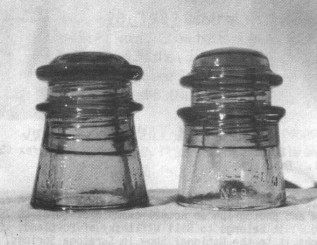
In the first photo notice the insulator on the left. It is a newcomer in a
pretty green and is embossed CRISTALERIAS DE CHILE / No. 10 ART: 44. The
insulator to the right is a CD 107 Whitall Tatum #9 and we show it for size
comparison.
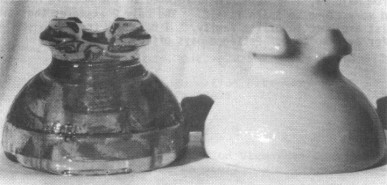
The second photo shows two insulators both of which are embossed CRISTALERIAS
DE CHILE / No 6510. The styles are identical but the colors are different. The
one on the left is a citrony yellow green, while the insulator on the right is
an ivory milkglass. WOW!! Both of these jewels measure 5-3/8" across the
base and stand 3-3/4" tall. They have been given CD 299.5.
How exciting to be able to say we now have identified 6 of the 7 styles that
were supposedly made by this Santiago firm, CRISTALERIAS DE CHILE. These CD's
are 108.5, 113, 154, 203, 209 (see CROWN JEWELS, January, 1987) and CD 299.5.
Interesting, too, to notice that these are just about identical to American
styles, even down to our Standard pinhole and thread size. Looks like maybe they
copied our designs after first using imports from America? I'm guessing, I don't
really know if they did or not. But I do know that several South American
countries produce insulators that could pass for American styles if you weren't
wearing your glasses to read the embossings.
Thanks go to Joe Maurath, Bill
Willinsky and Ward Lindstrom for making it possible to share these insulator
finds with you. It takes a lot of trust to send off your treasures in the mail,
no matter how well they are packed.
Those of you who have the First Revision of
GLASS INSULATORS FROM OUTSIDE NORTH AMERICA will want to make note of these new
CD numbers in your book.
| 